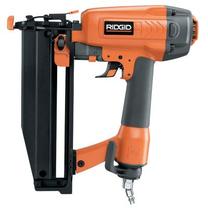Ridgid 2 ½-inch Straight Finishing Nailer model R250SFA
![]()
![]()
![]()
![]()
![]()
![]()
![]()
![]()

Nailing trim by hand was originally devised as method of punishing unrepentant criminals who stubbornly refused to recycle their plastic bottles. Outlawed in several European countries as barbaric, cruel and inhumane, the practice remains legal in most jurisdictions in North America. Despite the outrage expressed by human rights agencies around the world, the carnage prevails to this day.
While it seems like a trivial matter, driving hundreds of finishing nails into wooden baseboards and moldings without splitting the wood or mashing your fingers is about as easily accomplished as getting a believable answer out of a Canadian cabinet minister.
An air nailer is a carpenter’s equivalent of strapping one’s elected official to a chair, pumping said pol full of sodium pentothal and rolling a few tape recorders. Connected to a suitable source of compressed air, such a device can drive a finishing nail with unerring precision in less time than it takes to swing a hammer once. If you set up an air nailer correctly, it will countersink its nails neatly below the surface of the wood being nailed, too.
Once the exclusive province of professional contractors, air nailers got cheap a few years ago, and really good ones can presently be had for about a hundred dollars.
An air nailer is a very simple machine – it consists of an air cylinder to drive nails, a valve to let air into the air cylinder – typically controlled by a trigger – and a rack and spring to push strips of special nails into the mechanism. Contemporary air nailers have nothing much to adjust, very little to go wrong and despite the loud noises and extremely rapid movements of sharp bits of steel they get involved with, are remarkably safe to use.
The only catch inherent in air nailers is that they’re substantial blocks of steel that you’ll need to hold at arm’s length when they’re in use. One of the really cool aspects of an air nailer is that it can be operated with one hand, allowing its operator use his or her other hand to position that which is being nailed. In this configuration, the hand that holds an air nailer will quickly find itself attached to a very sore arm.
The Ridgid 2 ½-inch air nailer distinguishes itself largely by its metallurgy. Its case, rather than being wrought of steel, is formed of magnesium, a significantly lighter metal. The reduction in weight of the Ridgid nailer makes it a much more comfortable tool, even if you have a whole house worth of trim to impale. You can use it for hours without the need of anabolic steroids, physiotherapy or aspirins the size of manhole covers.
In use, the Ridgid nailer is so effortless that you’ll be certain you’ve forgotten to do something. It can be connected to any suitable air compressor – while air nailers make a substantial amount of noise and seem to be altering the fabric of time and space every time you fire one, they don’t actually require a huge volume of air to operate. A small, portable air compressor will drive the Ridgid nailer. Loading nails into it is effortless.
The manual that accompanies the Ridgid nailer makes mention of how to clear a jammed nail from the device, but having now blown through the box of a thousand nails that came with our nailer and not had one jam, I can’t comment on this aspect of its operation. It seems to be jam-proof, a quality not readily associated with these things a few years ago.
The only maintenance issue associated with the Ridgid nailer is its need for a few drops of air tool oil every time you use it – a small bottle of oil accompanies the nailer. Once again, this is a decided improvement from earlier nailers, which were serious pigs to keep running.
The Ridgid 2 ½-inch finishing nailer comes in a convenient plastic case. It has a manual that’s enviable for its brevity – there’s little to say about the operation of the machine once you’ve figured out where the nails go, and almost all its text consists of safety warnings.
Once you get up to speed with the nailer, it’s disturbingly quick. It can be configured to fire a nail each time its trigger is depressed, or each time it’s pressed to a surface to be nailed. The latter mode, while wanting somewhat in accuracy, does get a lot of nails in place.
It’s worth noting that the nailer can’t be discharged like a gun – unless it’s pressed against something to be nailed, it won’t fire. As such, while it should be treated with the same concern and wariness accorded anything capable of nailing your face to the floor, it’s an extremely safe device in practice.
In accordance with the claims at the Ridgid web page, you really can drive a finishing nail through solid oak with this nailer. I was impressed. When all the trim’s done, we’re planning to build bookshelves.
While most of the nailers we tried were well made and easy to use, the light weight of the Ridgid nailer was easily worth its slightly higher price. After a few hours of nailing and the rest of the day spent in loftier pursuits, it felt worth whatever it cost.